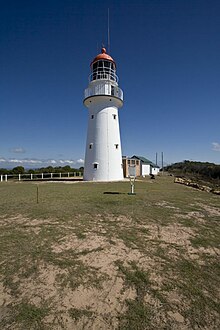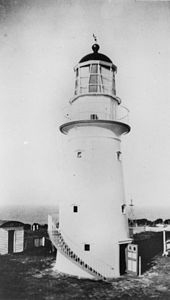Bustard Head Light
 Bustard Head Light in 2006 | |
 | |
| Location | Seventeen Seventy, Gladstone Region, Queensland, Australia |
|---|---|
| Coordinates | 24°01′20″S 151°45′52″E / 24.022303°S 151.764492°E |
| Tower | |
| Constructed | 1868[1] |
| Construction | cast iron tower[4] |
| Automated | 1986 |
| Height | 58 ft (18 m) |
| Shape | conical tower with balcony and lantern |
| Markings | white (tower), red (dome) |
| Power source | mains electricity |
| Operator | Australian Maritime Safety Authority |
| Heritage | listed on the Queensland Heritage Register |
| Light | |
| Focal height | 336 ft (102 m) |
| Lens | AGA 250mm rotating lens |
| Intensity | 200,000 cd[2] |
| Range | 21 nautical miles (39 km; 24 mi)[3] |
| Characteristic | |
Bustard Head Light is an active lighthouse located on the southeast tip of Bustard Head, a headland, about 20 kilometres (12 mi) northwest of Seventeen Seventy, in the Australian state of Queensland, within the Eurimbula National Park and locality of Eurimbula. Built in 1868, it is the second-oldest lightstation in the state,[5] following Cape Moreton Light,[6] and the first to be built in Queensland after its formation in 1859.[5][5] It is also one of the first in Australia to be constructed using bolted prefabricated segments of cast iron,[5] and one of only two such lighthouses in Queensland, the other being its sibling, Sandy Cape Light.[5] It serves as the central relay for Dent Island Light, Pine Islet Light and Lady Elliot Island Light and as the radio check post for Cape Capricorn Light, Sandy Cape Light and Double Island Point Light.[5]
Bustard Head was named by
History


The

In May 1932 the original cottages were destroyed in fire.[6] In 1935 the stairs which were originally outside the tower were relocated within the tower.[5] The lighthouse was automated during 1985–86, and finally de-manned in 1986,[5] leaving it to neglect and vandalism for the next 16 years. In 2001 the Bustard Head Lighthouse Association, a volunteer organisation led by Stuart Buchanan, obtained a twenty-year lease on the premises and started restoring it using funds from a federal grant, local businesses and self-funding. The station was fully restored, and it is now managed by the association.[10]
Current display
The current
Structures
The lighthouse is conical in form. It stands 18 metres (59 ft) high, constructed of prefabricated cast iron plates, and painted white, with splayed flanges at the base, much like the Sandy Cape Light. The tower is topped by a
The residences at the station consist of two one-storey
Another notable structure at the station is an old powerhouse, timber-framed and clad with cement sheet and a gabled corrugated fibro cement roof with stainless-steel gutters.[5] The new powerhouse is brick constructed on a concrete foundation.[5]
Other structures include a fenced[5] fuel store, a tool shed, a garage/stores shed, and a bulk fuel farm.[5] They are mostly timber-framed and clad with fibro.[5]
Also on the premises is a cemetery surrounded by a white picket fence, located about 300 metres (980 ft) northeast of the station. It contains nine graves dating from 1879 to 1911 as well as two unmarked, child-sized graves.[5]
Site operation and visiting
The light is operated by the Australian Maritime Safety Authority. The site is managed by the Bustard Head Lighthouse Association. The site is accessible by boat only.[14] The site and tower are open to tours which are available daily.[13]
See also
Notes
- ^ Searle and AHD19181. Rowlett and Lighthouses of Australia Inc lists 1869.
- ^ a b Lighthouses of Australia Inc. AHD19181 states 650,000 cd.
- ^ a b List of Lights and Lighthouses of Australia Inc. AHD19181 states 25 nmi, consistent with the higher intensity.
- ^ AHD19181 goes in length about the lighthouse being "totally cast iron". Rowlett states "wood frame tower covered by cast iron panels".
- ^ a b c d e f g h i j k l m n o p q r s t u v w x y z AHD19181.
- ^ a b c Exhibition.
- ^ History, Settlement.
- ^ a b AHD100383.
- ^ Low Isles Light.
- ^ a b Buchanan 2007.
- ^ List of Lights
- ^ Lighthouses of Australia Inc.
- ^ a b Rowlett.
- ^ "Bustard Head Lighthouse". Lighthouses of Australia Inc. 26 January 2018. Archived from the original on 11 November 2022. Retrieved 17 January 2023.
References
- List of Lights, Pub. 111: The West Coasts of North and South America (Excluding Continental U.S.A. and Hawaii), Australia, Tasmania, New Zealand, and the Islands of the North and South Pacific Oceans (PDF). List of Lights. United States National Geospatial-Intelligence Agency. 2009. p. 207.
- Rowlett, Russ. "Lighthouses of Australia: Southern Queensland". The Lighthouse Directory. University of North Carolina at Chapel Hill. Retrieved 14 November 2010.
- "The Bustard Head Lighthouse". Lighthouses of Queensland. Lighthouses of Australia Inc.
- Searle, Garry. "List of Lighthouses - Queensland". Lighthouses of Australia. SeaSide Lights.
- "Bustard Head Lightstation, Turkey Beach, QLD, Australia (Place ID 19181)". Australian Heritage Database. Australian Government.
- "Cape Cleveland Lightstation Precinct, Cape Cleveland via Townsville, QLD, Australia (Place ID 100383)". Australian Heritage Database. Australian Government.
- "Queensland's History : Queensland Government". qld.gov.au. Archived from the original on 20 August 2010. Retrieved 30 November 2010.
- "Bustard Head Lighthouse Exhibition" (PDF). Queensland State Archives. Archived from the original (PDF) on 17 February 2011.
- Buchanan, Stuart (Summer 2007). "My Favourite Place" (PDF). Time & Place, Queensland's Cultural Heritage Newsletter (17). Archived from the original (PDF) on 23 February 2011.
- "The Low Isles Lighthouse". Lighthouses of Queensland. Lighthouses of Australia Inc.
External links
![]() Media related to Bustard Head Light at Wikimedia Commons
Media related to Bustard Head Light at Wikimedia Commons

